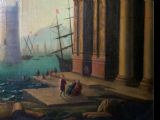Claude Lorrain Port Of Ostia Rome Marine Oil Portrait Seascape Painting
Price
£18,500
| $24,740 USD | €21,192 EUR
Item Ref
CLC/060/RBC
Description
IDENTIFIED AS “ PORT OF OSTIA ROME “By Follower of Claude Lorrain.
This scene originally first painted In 1643
Produced in 1931 as a coloured lithograph by Messrs Knoedler which has been recently purchased and is available with the painting to compare scenes.
I could not find out which museum might have custody of the original 1634 painting, and am actively investigating the origins of our example which is an extremely accurate version and composition by an accomplished artist familiar with Claude Lorrain’s most famous works.
This fine rendition is a fabulous example of one of his most notorious seaport scenes and captures the imagination and eye of the most particular of art connoisseurs and is becoming hard to find such fine works for sale in today’s galleries without having to pay huge sums of money.
All of the well known international art galleries house on display most of his best and prized works, unavailable for private ownership.
All of his works were characterised by the softness of the brushwork, which was portrayed in the first half of Lorrain''s career.
Despite their identical composition, the paintings differ in minor details, like: different positions and number of ships, different staffage, etc.
This seascape combines architectural fantasies and real ruins; the Roman arch and the portico, the medieval towers behind them, and, still further, an Egyptian pyramid.
The buildings merely serve to emphasize the main theme, that of the sea and the sunlight, which reflecting from the magnificent architectural decor, returns to the mirror-like surface of the sea.
The artist produced many versions of the same harbour scene, carefully painted at sunrise and sunset.
CLAUDE LORRAIN ( b.1600-d.1682 )
Claude Lorrain was a French painter, draughtsman and etcher of the Baroque era.
He born in the Duchy of Lorraine, which was then an independent state within the Holy Roman Empire.
He travelled to Italy in 1613 and studied with the Italian perspective specialist and landscape painter, Agostino Tassi. By 1627 he had settled in Rome in the ‘artists’ quarter’, where he remained for the rest of his life.
LOCATION & ANALYSIS
This harbour scene approaches Roman ruins with the same wonderment that Claude approached the Campagna: in reality the Arco degli Argentieri (Arch of the Money-Changers) was in a squalid corner of Rome, but here it is the glorious frame of an idealised harbour with a walled port in the background, protected by two venerable towers.
The activities of the figures similarly seem to be calculated to create a mood rather than describe the Italian street: two noble figures contemplate a voyage, while bales of cloth and caskets of treasure are unloaded and a man sleeps (associating the setting sun with well-earned repose).
Claude’s other strength, acknowledged by his biographers, was his command of perspective: here a strict vanishing point dictates the perspective of the comfortably solid architecture and pavement. The sun also sets on the vanishing point and every part of the tone and colour of the painting is dictated by its distance from this point.
SIGNATURE
Indistinctly signed, oil on canvas set within a later heavy oak and gilt gesso moulded frame.
HUGE FRAMED DIMENSIONS
HEIGHT: 50.4 Inches ( 128 cm )
WIDTH : 63.8 Inches ( 162 cm )
DEPTH: 3.6 Inches ( 19 cm )
CONDITION
Very Good Order after historic reline with faint stable craquelure in places as would be normal.
Frame in lovely order with evidence of only an odd minor repair.
DELIVERY
UK Specialist Art Courier £200 Allow 7-10 Days
WORLDWIDE : Crating £400 + Air Freight £1000
TELEPHONE ENQUIRIES: 07765 856171
Quote Ref: CLC/060/RBC
Payments are accepted by Bank Transfer & by Debit / Credit Cards Via the BUY NOW Payment Link Tab shown below each items description.
PAY-PAL Account Holders are welcome. CHEQUES Drawn from UK banks.
Internal Ref: CLC/060/RBC
Dimensions
Height = 128 cm (51")Width = 162 cm (64")
Depth = 9 cm (4")
We accept online payments for this item:
BUY NOW with CREDIT CARD or PAYPAL
Email about this item:
SEND EMAIL




















